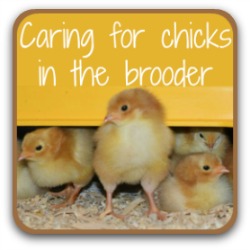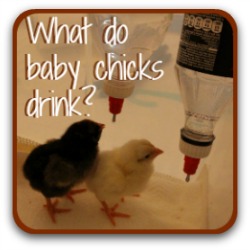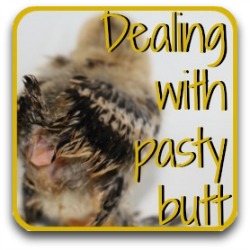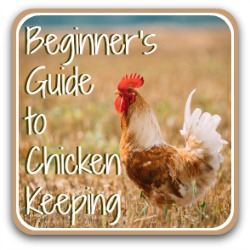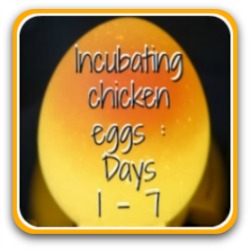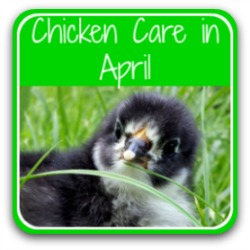- Home
- Chicks in the Brooder
- Culling
How to cull a chick: be prepared.
You won't want to, but one day you'll have to cull a chick. Here are your options.
- Please note: Some people will find the information contained on this page painful. If you're one of them, please either be prepared - or don't go any further.
- I am not discussing nor advocating culling chicks because they're male, or for any reason other than that the chick is so ill there is no alternative.
- Also note that the processes discussed here are NOT appropriate for adult hens or for any other creatures. They are for newly hatched, up to one day old chicks only.
- For best advice about culling adult chickens, see this article.
When is it time to cull?
This is a judgement call we all have to make individually. Each situation is different, and each individual will have a personal view. The important thing is to find a way which will cause you, and the chick, the least possible distress.
The bottom line is this question :
"Does this chick have, or is she ever going to have, a good quality of life?"
If the answer to that question is a definitive "No", then it's time to cull.
If you're still not sure, here are some more questions to ask yourself.
- Is she eating and drinking?
- Is she spending most of her time asleep, even after the first two days post-hatch?
- Is she thriving? - i.e. is she growing as well as the other chicks?
- Or does she look weak?
- Does she have a condition you, or your veterinary practitioner, may be able to help with?
- Are you satisfied that you have done everything possible to save her life?
Ask yourself, too, whether you are holding off taking action for your own sake. It's hard to make this decision, but at the end of the day it's the kindest thing we can do for animals in our care if they are very unwell.
Do not, on any account, leave a chick in obvious incurable distress or pain because you can't bring yourself to euthanise her. That is unfair and unkind. It's heartbreaking, but the most humane thing we can do for a sick chick is to help her die in a dignified and peaceful manner.
Different ways to cull.
When I had to cull a very sick chick, I carefully researched different methods before choosing the one which felt kindest and which I had confidence in my own ability to do quickly, causing the least possible distress. Before I discuss that method, here are some others I found which I could not, for my own reasons, use.
Snipping the neck.
This is the quickest and most humane way to kill a very young chick. At this age (under two days post-hatch) the spine is soft and breaks easily.
How to do it: Using a pair of sharp scissors, simply snip off the head.
- Many people in rural areas use this method. It's so quick as to be painless for the chick.
- It can be distressing for the person doing it. It involves a small quantity (about a tablespoon) of blood.
- It's the method I would recommend for a sick chick.
Breaking the neck.
This is also sometimes called 'thumbing'. When done properly, it is another quick and painless way to cull.
How to do it: flick the neck backwards over your thumb.
- Do not attempt this unless you know what you're doing, and can be certain of doing it effectively. There's a real danger of causing extra pain, and possibly not killing cleanly.
- If you're unable to face doing it yourself but you know someone who can, it's reasonable to ask them to help so that you learn from their knowledge.

Using ether or starter fluid.
How to do it: place the chick into an airtight container. Drop starter fluid onto an absorbent pad next to it.
- I do not recommend this method.
- The starter fluid is known to burn, and is thought to cause pain before it takes effect.(1)
Veterinary visit.
How to do it: Take your sick chick to a veterinary surgeon who will administer a lethal injection.
- This option depends almost entirely on personal circumstances: cost, time, distance, availability of an avian vet, for example.
- If circumstances are right, this is certainly a quick, pain-free option.
The 'baking soda' method.
Again, please note: this method is NOT suitable to cull anything other than an ill chick who is less than two days old.
How to do cull a chick using this method.
This is the method I first chose when I had no choice but to cull. It's quick, easy to do and doesn't require skills I don't have.
It will not be to everyone's liking, and there are no studies on very young chicks to assess exactly how much pain it may cause.
Anecdotal evidence is that the chick is unconscious very quickly and dies in under a minute(1).
What you need.
One of the benefits of this method is that you probably have everything you need in your store cupboard.
- One airtight container - I used a 'Tupperware' box
- One smaller container - I use a smaller 'Tupperware' box
- Baking soda (also known as bicarbonate of soda) - enough to cover the smaller container to about half an inch depth
- White vinegar - about half a cup.
Arrange the smaller container inside the larger. I added a cloth bed for the chick to lie on, and a pad of paper towel underneath the smaller box, in case of spillage.
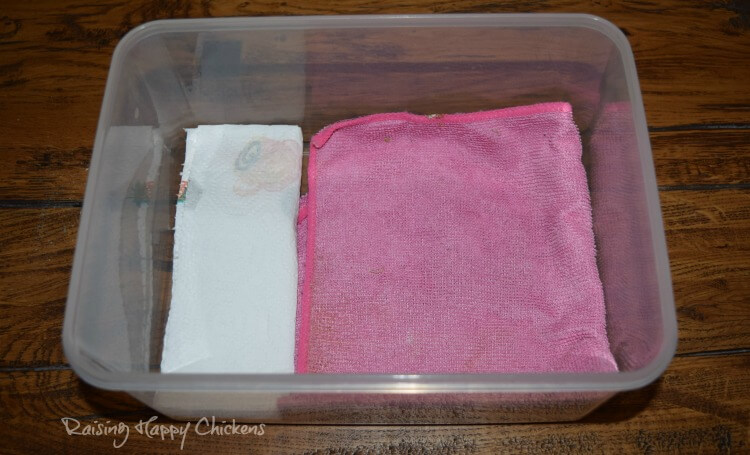 Add bedding and a paper towel.
Add bedding and a paper towel.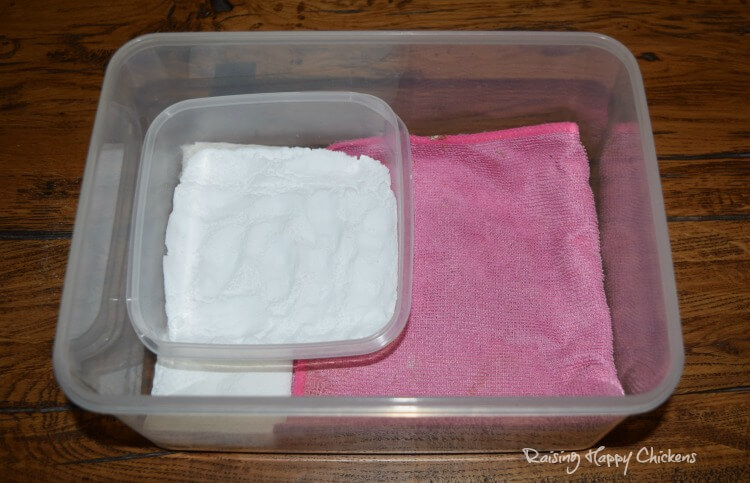 Add the baking soda to the smaller box
Add the baking soda to the smaller box- Place the chick in the large box.
- Add the vinegar to the small container.
- Close the lid immediately.
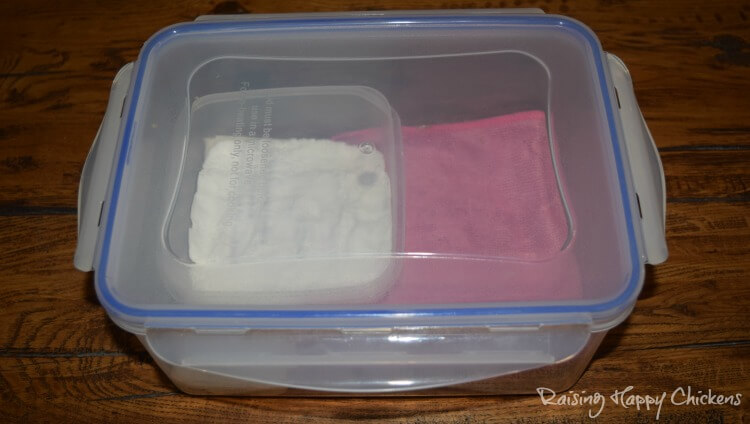 Make sure the box closes tightly.
Make sure the box closes tightly.- The reaction between the baking soda and vinegar causes a bubbling which releases carbon dioxide. The bubbling calms down in a few seconds and you'll notice the liquid becoming brown.
- If you have a transparent box, you're likely to see the chick slump to one side almost straight away. After a few seconds you may see her flap a wing slightly. This is a reflex action and does not mean she is conscious.
- Leave the lid on the box for several minutes to make sure the chick has gone, before opening the lid. She will look as though she has just fallen asleep.
- I always bury my chickens in a special memorial area in a peaceful wooded part of our garden which is covered in poppies in the spring and marigolds (which chickens love) in the summer.
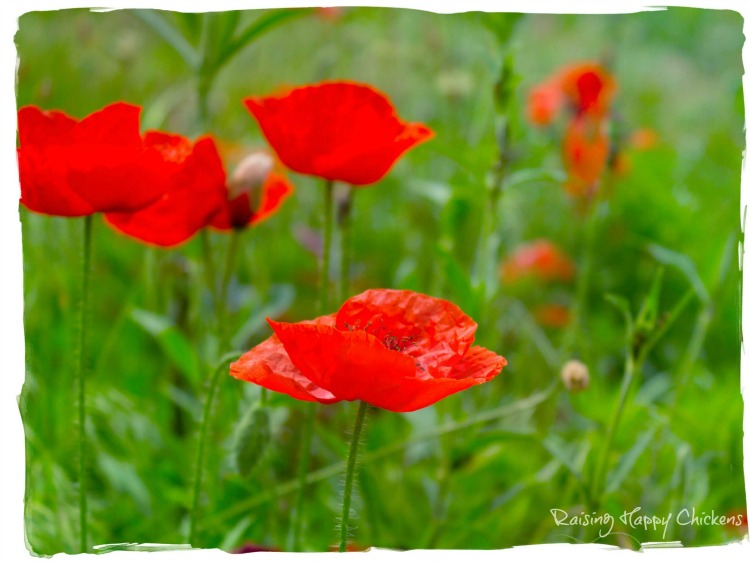
Have you lost a chick you'd like to pay tribute to?
Writing a tribute to a lost chick (or chicken) can help with the grieving process.
Clicking on this image will take you to a page where you can leave your own tribute.
Tributes will be published as soon as possible, and if you so choose, you'll be informed when yours is live on this website.
Thank you for your patience.
How to keep happy, healthy chicks.
Most chicks who hatch will be healthy and happy. Here are some articles about how you can make sure they stay that way.
Resources and further reading.
J. K. Blackshaw et al : 'The behaviour of chickens, mice and rats during euthanasia with chloroform, carbon dioxide and ether'. Pub. Journal of Laboratory Animals, 1988.
- Home
- Chicks in the Brooder
- Culling


